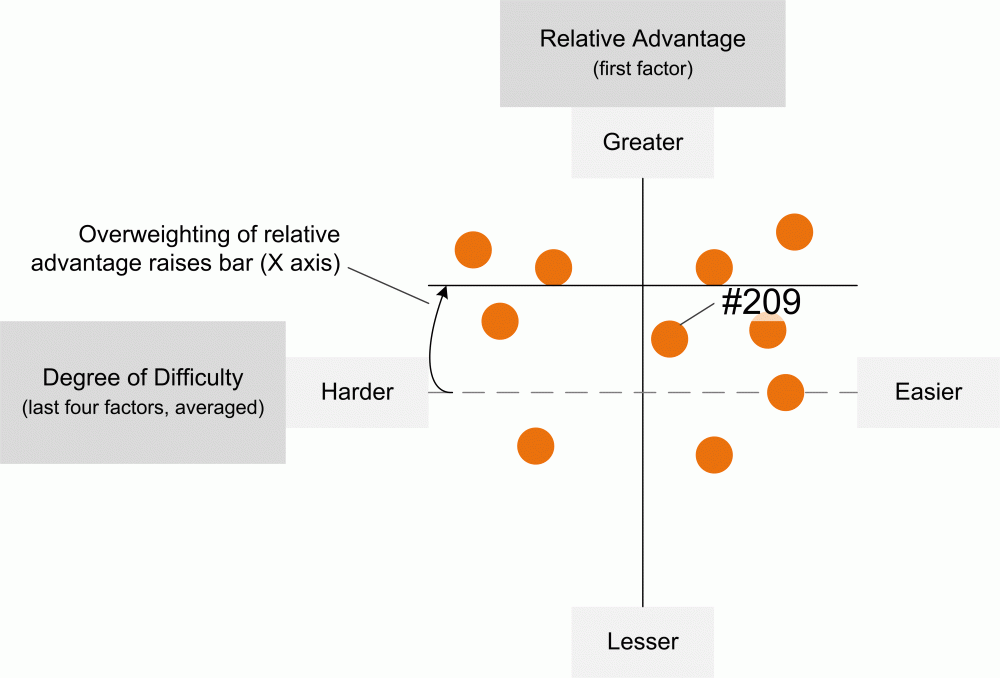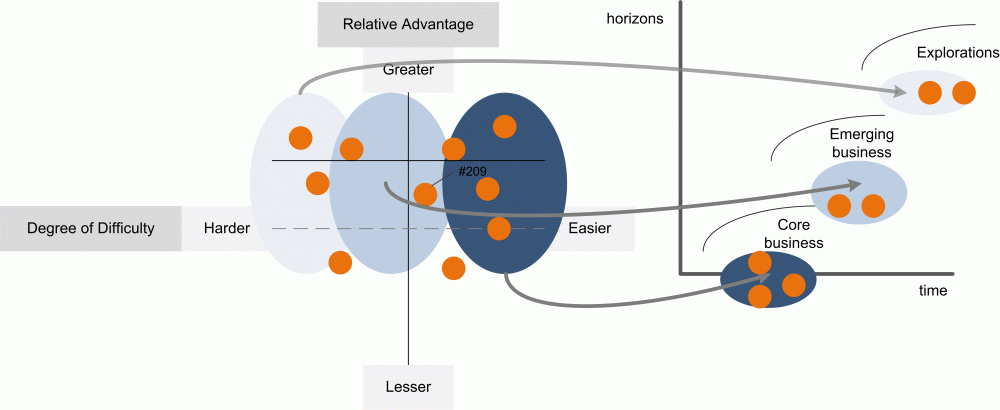Our Cup Runneth Over
The organization succeeded with its latest innovation campaign. Community members resonated with the critical question the campaign team framed. They held firsthand experience about the subject. Their experience helped them connect the implications their ideas indicated with reality. They committed to contributing fully formed ideas. The campaign sponsor engaged the community throughout the process. Their participation opened the door to deeper engagement. The process helped some to more fully realize their potential for leadership.
Life is good. People smile at one another in the hallways.
Now what?
In this article I suggest a way for campaign teams to evaluate and frame the ideas that resonate with the community. To do so, I apply Everett Rogers’ Diffusion of Innovations and Mehrdad Baghai’s Alchemy of Growth. Both books offer people who practice collaborative innovation valuable insights. Ideas that move from the front to the back end of innovation through this process evolve to become concepts.
Does the Idea Have Legs?
In the Diffusion of Innovations Rogers addresses the critical question of why some people embrace some ideas and disregard others. He identifies five characteristics of an innovation—the tangible realization of an idea—which influence whether they do so or not. This model does not apply in cases where someone mandates that people adopt an idea (e.g., “You will wear a lime green jumpsuit on Thursdays”).
- Relative Advantage: the extent to which the innovation improves upon the current approach
- Compatibility: the extent to which the innovation jibes with the person’s current practices and environment
- Complexity: the extent to which the person must make an effort to use the innovation (the learning curve)
- Trialability: the extent to which the person can try the innovation before committing fully to embracing it
- Observability: the extent to which the person can see and, thus, communicate the benefits of the innovation to their colleagues
Further, Rogers found that the first factor—relative advantage—outweighed the other four in importance.
We can observe that the first factor—relative advantage—speaks to the idea’s upside: what benefit does the idea offer if we pursue it? The remaining four speak to elements that comprise degree of difficulty: How hard would it be for us to implement the idea?
Imagine, by way of example, asking your campaign team to score each idea by the five criteria, perhaps by using a Likert scale as follows (figure 1).
Figure 1: example of a Likert scale for evaluating an idea
Imagine that the campaign team scores a hypothetical idea (“Idea #209”), as follows, on a scale of 1 to 4.
- Relative Advantage: 3.7
- Compatibility: 2.3
- Complexity: 3.2
- Trialability: 2.1
- Observability: 3.9
You separate the two sets of factors and weight the first, Relative Advantage, as follows (figure 2).
Figure 2: calculating the five factors for the example idea #209
You then plot Idea #209 and its counterparts from the campaign on a Hi-Lo chart, as follows (figure 3).
Figure 3: ideas positioned on the Hi-Lo chart by their evaluation scores
The campaign team and sponsor now have a way to reflect on an idea’s potential, relative to the likelihood that the people who represent its intended audience will embrace it.
Does this approach represent the final, formulaic word on which ideas to pursue? No. Exercise discretion. The campaign team may want to present the factors in new ways on the Hi-Lo chart to compare the ideas further. They will want to have dialogue on the underlying assumptions that guided their ratings.
This approach gives the campaign a means of visualizing and thinking about the ideas that the community contributed and that resonated with them as a whole, in a way that jibes with what we know about the adoption of innovation. Seeing the whole and engaging in dialogue on the map becomes the critical conversation.
Businesses, Not Ideas, Disrupt
Let’s extend our example. Clients at times ask me to help them identify potentially disruptive ideas from amongst the group that their community submitted. This request challenges me. In reality, many ideas—properly formed and supported—have the potential to serve as the genesis of an innovation that disrupts a business model. Turning lead into gold remains a possibility with the world of collaborative innovation.
The reason why devotees of Clayton Christensen struggle with being the business that disrupts and not the business being disrupted is because they do not frame their business in a way that accommodates disruptive ideas. In particular, core, established businesses have a way of suffocating potentially disruptive ideas because the first business they threaten to disrupt is often their own.
One way to overcome this challenge is to couch the business in a way that can accommodate various forms of innovation, disruptive or otherwise. To this end, I have found that the concept of the Three Horizons of Growth, which Baghai describes in the Alchemy of Growth, works well (figure 4).
Figure 4: three horizons model
In brief, the Three Horizons of Growth suggests that every organization is, in reality, three businesses, each with its own horizon.
- Horizon one represents the core businesses—the business that provides the cash flow and the brand.
- Horizon two represents emerging business opportunities—businesses that promise substantial profits but require additional, large investments to realize them.
- Horizon three represents explorations —explorations which, if successfully pursued, may lead to the development of new, emerging businesses that may, in turn, become the core some day.
Successful companies continuously nurture activity in all three horizons, currently.
Tying It All Together
Let’s return to our example and Hi-Lo chart (figure 5). Look to the upper right quadrant. You may see ideas that offer great advantage and are easy to implement. These may map to your core business. You fully understand your core business and, by extension, you fully understand the challenges involved with trying the ideas in the core. By contrast, another organization working outside your core may assess these same set of ideas as harder to implement because they have no experience that would give them the confidence that they could overcome the challenges. Knowledge of your core can serve as a powerful competitive weapon.
Figure 5: seeing the whole–mapping ideas to the horizon where it makes sense to pursue them
Now go to the upper left quadrant of the chart. You may see ideas that promise great advantage, but would be hard to implement. Ask yourself: Is it because it’s just beyond your core—beyond your firsthand understanding? You may have identified ideas that would form the basis of new explorations that would lead to insights about new opportunities and, potentially, disruptive innovations.
The mappings I suggest by way of this simple example will not be as straightforward in practice. As always, use your discretion. The benefit that this approach offers is that it gives you a framework and a place to start the critical conversation on what does it mean to incubate ideas in the context of the three horizons in which you operate today, whether you do so in a conscious way or not.
In closing, I would value insights that you have gained from navigating this critical juncture in the larger practice of collaborative innovation. What has been your experience?
About the Author:
 Doug Collins serves as an innovation architect. He has served in a variety of roles in helping organizations navigate the fuzzy front end of innovation by creating forums, venues, and approaches where the group can convene to explore the critical question. He today works at Spigit, Inc., where he consults with Fortune 1000 clients on realizing their vision for achieving leadership in innovation by applying social media and ideation markets in blended virtual and in-person communities. Previously, Doug formed and led a variety of front end initiatives, including executive advisory programs for industry influencers, early adopter programs for lead users, corporate strategic planning, and structured explorations of new market and product opportunities. Before joining Spigit, Doug worked at Harris Corporation and at Structural Dynamics Research Corporation which is now part of Siemens Corporation.
Doug Collins serves as an innovation architect. He has served in a variety of roles in helping organizations navigate the fuzzy front end of innovation by creating forums, venues, and approaches where the group can convene to explore the critical question. He today works at Spigit, Inc., where he consults with Fortune 1000 clients on realizing their vision for achieving leadership in innovation by applying social media and ideation markets in blended virtual and in-person communities. Previously, Doug formed and led a variety of front end initiatives, including executive advisory programs for industry influencers, early adopter programs for lead users, corporate strategic planning, and structured explorations of new market and product opportunities. Before joining Spigit, Doug worked at Harris Corporation and at Structural Dynamics Research Corporation which is now part of Siemens Corporation.












